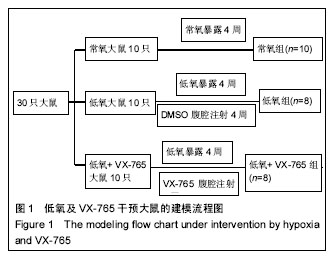| [1] Dinenno FA. Skeletal muscle vasodilation during systemic hypoxia in humans. J Appl Physiol (1985). 2016;120(2): 216-225.[2] Horscroft JA, Murray AJ. Skeletal muscle energy metabolism in environmental hypoxia: climbing towards consensus. Extrem Physiol Med. 2014;3(1):19.[3] 薄海,彭朋,段富强,等.高原习服进程中淋巴细胞线粒体生物合成和自噬的变化规律[J].武警后勤学院学报(医学版), 2014,23(7): 553-556.[4] Kiernan EA, Smith SM, Mitchell GS, et al. Mechanisms of microglial activation in models of inflammation and hypoxia: Implications for chronic intermittent hypoxia. J Physiol. 2016;594(6):1563-1577. [5] Elliott EI, Sutterwala FS. Initiation and perpetuation of NLRP3 inflammasome activation and assembly. Immunol Rev. 2015; 265(1):35-52. [6] Abderrazak A, Syrovets T, Couchie D, et al. NLRP3 inflammasome: from a danger signal sensor to a regulatory node of oxidative stress and inflammatory diseases. Redox Biol. 2015;4:296-307. [7] Jo EK, Kim JK, Shin DM, et al. Molecular mechanisms regulating NLRP3 inflammasome activation. Cell Mol Immunol. 2016;13(2):148-159. [8] Besedovsky HO, Del Rey A. Physiologic versus diabetogenic effects of interleukin-1: a question of weight. Curr Pharm Des. 2014;20(29):4733-4740.[9] Zhang Y, Zheng Y. Effects and mechanisms of potent caspase-1 inhibitor VX765 treatment on collagen-induced arthritis in mice. Clin Exp Rheumatol. 2016;34(1):111-118. [10] 中华人民共和国科学技术部.关于善待实验动物的指导性意见. 2006-09-30. [11] Noe FM, Polascheck N, Frigerio F, et al. Pharmacological blockade of IL-1β/IL-1 receptor type 1 axis during epileptogenesis provides neuroprotection in two rat models of temporal lobe epilepsy. Neurobiol Dis. 2013;59:183-193. [12] Jiang N, Bo H, Song C, et al. Increased vulnerability with aging to MPTP: the mechanisms underlying mitochondrial dynamics. Neurol Res. 2014;36(8):722-732. [13] Li H, Miao W, Ma J, et al. Acute Exercise-Induced Mitochondrial Stress Triggers an Inflammatory Response in the Myocardium via NLRP3 Inflammasome Activation with Mitophagy. Oxid Med Cell Longev. 2016;2016:1987149. [14] Bo H, Kang W, Jiang N, et al. Exercise-induced neuroprotection of hippocampus in APP/PS1 transgenic mice via upregulation of mitochondrial 8-oxoguanine DNA glycosylase. Oxid Med Cell Longev. 2014;2014:834502.[15] Kang C, Goodman CA, Hornberger TA, et al. PGC-1α overexpression by in vivo transfection attenuates mitochondrial deterioration of skeletal muscle caused by immobilization. FASEB J. 2015;29(10):4092-4106. [16] Sollberger G, Strittmatter GE, Grossi S, et al. Caspase-1 activity is required for UVB-induced apoptosis of human keratinocytes. J Invest Dermatol. 2015;135(5):1395-1404. [17] Ham PB 3rd, Raju R. Mitochondrial function in hypoxic ischemic injury and influence of aging. Prog Neurobiol. 2016. in press.[18] Abais JM, Xia M, Zhang Y, et al. Redox regulation of NLRP3 inflammasomes: ROS as trigger or effector? Antioxid Redox Signal. 2015;22(13):1111-1129.[19] 薄海,李玲,段富强,等.低氧复合运动抑制低氧诱导的骨骼肌线粒体DNA氧化损伤[J].生理学报,2014,66(5):597-604.[20] 薄海,李玲,段富强,等.低氧联合运动对大鼠骨骼肌线粒体自噬的影响[J].中国康复医学杂志,2014,29(10):908-912.[21] 肖频,庞奕辉,彭朋,等.α-硫辛酸抑制慢性低氧大鼠骨骼肌线粒体的氧化应激[J].中国组织工程研究,2013,17(28):5216-5222.[22] Dashdorj A, Jyothi KR, Lim S, et al. Mitochondria-targeted antioxidant MitoQ ameliorates experimental mouse colitis by suppressing NLRP3 inflammasome-mediated inflammatory cytokines. BMC Med. 2013;11:178.[23] T?zsér J, Benk? S. Natural Compounds as Regulators of NLRP3 Inflammasome-Mediated IL-1β Production. Mediators Inflamm. 2016;2016:5460302.[24] Peake JM, Della Gatta P, Suzuki K, et al. Cytokine expression and secretion by skeletal muscle cells: regulatory mechanisms and exercise effects. Exerc Immunol Rev. 2015; 21:8-25.[25] Ystgaard MB, Sejersted Y, Løberg EM, et al. Early Upregulation of NLRP3 in the Brain of Neonatal Mice Exposed to Hypoxia-Ischemia: No Early Neuroprotective Effects of NLRP3 Deficiency. Neonatology. 2015;108(3): 211-219.[26] Gurung P, Lukens JR, Kanneganti TD. Mitochondria: diversity in the regulation of the NLRP3 inflammasome. Trends Mol Med. 2015;21(3):193-201.[27] Hutton HL, Ooi JD, Holdsworth SR, et al. The NLRP3 inflammasome in kidney disease and autoimmunity. Nephrology (Carlton). 2016;21(9):736-744.[28] Zhuang Y, Ding G, Zhao M, et al. NLRP3 inflammasome mediates albumin-induced renal tubular injury through impaired mitochondrial function. J Biol Chem. 2014;289(36): 25101-25111.[29] Mastrocola R, Penna C, Tullio F, et al. Pharmacological Inhibition of NLRP3 Inflammasome Attenuates Myocardial Ischemia/Reperfusion Injury by Activation of RISK and Mitochondrial Pathways. Oxid Med Cell Longev. 2016;2016: 5271251.[30] López-Armada MJ, Caramés B, Martín MA, et al. Mitochondrial activity is modulated by TNFalpha and IL-1beta in normal human chondrocyte cells. Osteoarthritis Cartilage. 2006;14(10):1011-1022.[31] Hatazawa Y, Senoo N, Tadaishi M, et al. Metabolomic Analysis of the Skeletal Muscle of Mice Overexpressing PGC-1α. PLoS One. 2015;10(6):e0129084.[32] Martínez-Redondo V, Pettersson AT, Ruas JL. The hitchhiker's guide to PGC-1α isoform structure and biological functions. Diabetologia. 2015;58(9):1969-1977.[33] Popov DV, Lysenko EA2, Kuzmin IV3, et al. Regulation of PGC-1α Isoform Expression in Skeletal Muscles. Acta Naturae. 2015;7(1):48-59.[34] Won TW. Fenofibrate, a peroxisome proliferator-activated receptor α-agonist, blocks lipopolysaccharide-induced inflammatory pathways in mouse liver. Korean J Hepatobiliary Pancreat Surg. 2013;17(3):89-108.[35] 薄海,彭朋,秦永生,等.低氧复合运动对大鼠骨骼肌线粒体含量的影响[J].中国病理生理杂志,2014,30(8):1461-1466.[36] Feng H, Kang C, Dickman JR, et al. Training-induced mitochondrial adaptation: role of peroxisome proliferator-activated receptor γ coactivator-1α, nuclear factor-κB and β-blockade. Exp Physiol. 2013;98(3):784-795. |
.jpg)


.jpg)